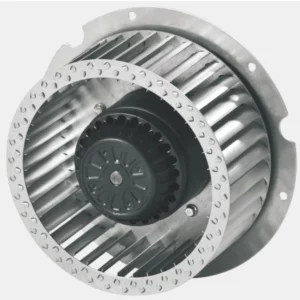Belt-driven centrifugal fans are widely used in various industries and applications to facilitate efficient air movement and ventilation. These fans employ a belt and pulley system to transmit power from the motor to the fan blades, offering advantages in terms of flexibility, ease of maintenance, and adaptability to different operating conditions. In this article, we will delve into the working principles of belt-driven centrifugal fans, highlighting their components and operation.
Understanding the Design
- Fan Housing:
Belt-driven centrifugal fans consist of a housing that houses the fan assembly, including the motor, belts, and pulleys, along with the fan blades. The housing is designed to optimize airflow and direct it in the desired direction. - Motor:
The motor is the power source of the fan and is typically mounted outside the fan housing. It drives the rotation of the fan blades through the belt and pulley system. - Belt and Pulley System:
The belt and pulley system consists of one or more belts connected to pulleys attached to both the motor shaft and the fan shaft. As the motor rotates, it transfers rotational energy to the fan blades through the belts and pulleys. - Fan Blades:
The fan blades are responsible for generating airflow by drawing air into the fan housing and propelling it in the desired direction. They are strategically designed to optimize air movement and efficiency.
Working Principles
- Power Transmission:
The belt-driven centrifugal fan operates based on the principles of power transmission. When the motor is turned on, it rotates the motor pulley. The rotational motion of the motor pulley is transferred to the fan pulley through the belt(s), resulting in the rotation of the fan shaft and blades. - Centrifugal Force:
As the fan blades rotate, they create centrifugal force, causing air to be drawn into the fan housing through the inlet. The rotating blades accelerate the air, increasing its velocity and pressure. - Air Movement and Discharge:
The accelerated air is then propelled towards the fan outlet, where it is discharged into the desired space or ventilation system. The design of the fan housing and blades determines the direction, velocity, and pressure of the airflow.
Benefits and Applications
- Flexibility:
Belt-driven centrifugal fans offer flexibility in terms of motor placement. The motor can be mounted remotely from the fan housing, allowing for easier installation and maintenance, especially in confined spaces or harsh environments. - Adaptability:
The belt and pulley system enables adaptability to different operating conditions. It allows for speed adjustments by changing the size of the pulleys or belt configuration, accommodating varying air volume and pressure requirements. - Reduced Noise and Vibration:
The belt-driven design contributes to reduced noise and vibration levels compared to direct-drive fans. The motor’s vibrations are isolated from the fan assembly, resulting in quieter operation and improved comfort in the surrounding environment. - Maintenance and Serviceability:
Belt-driven centrifugal fans are relatively easy to maintain and service. If a belt wears out or breaks, it can be replaced without requiring extensive disassembly of the fan assembly, reducing downtime and maintenance costs. - Applications:
Belt-driven centrifugal fans find applications in various industries, including HVAC systems for commercial buildings, industrial ventilation, manufacturing processes, and air handling units. They are also used in agricultural settings, such as barn ventilation systems, and in automotive cooling applications.
Belt-driven centrifugal fans offer efficient air movement and ventilation by utilizing a belt and pulley system to transmit power from the motor to the fan blades. Their design provides flexibility, adaptability, and ease of maintenance. With applications in HVAC, industrial ventilation, agriculture,belt driven centrifugal fan and automotive cooling, these fans play a crucial role in maintaining optimal air quality, temperature control, and comfort in diverse settings. The belt-driven design’s advantages make it a popular choice for air movement solutions across various industries and applications.
